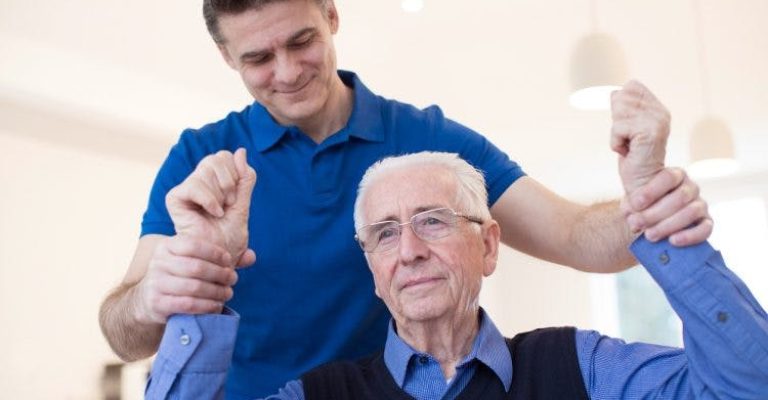
The onset of flaccidity following a stroke often takes place within the first few days of recovery after the event, but in extreme circumstances, it may persist. This condition is referred to as ataxia.
You are about to study the causes of flaccid paralysis as well as the therapies available for it so that you can have a better understanding of the effects of a stroke. Let’s begin.
Following a stroke, the first stage is flaccidity (also known as flaccid paralysis), which corresponds to the first stage in the Brunnstrom Stages. This time frame represents the initial period immediately following a stroke for some survivors of a stroke.
On the other hand, not all people who survive a stroke will exhibit total flaccidity even immediately after their stroke. Each stroke is unique, some people will have flaccidity that continues beyond the very initial period after suffering a stroke.
After suffering a stroke, the neurological connections that normally connect the brain to the muscles may become disrupted.
Flaccid paralysis prevents a person from initiating any voluntary movement on the side of their body that is affected by the condition.
Atrophy of the muscles can set in if the state of flaccidity persists for an excessively long time without treatment. After a stroke, flaccidity is frequently accompanied by a decrease in muscular tone, known medically as hypotonia.

Hypotonia is a term used to describe a low muscle tone that can be the result of damage to the brain, such as from a stroke (among other causes). Hypotonic muscles, on the other hand, will not have even a minute amount of contraction even when they are completely relaxed. Normal muscles will have this phenomenon.
Low muscle tone frequently occurs in conjunction with muscle weakness and numbness, and it can also contribute to an increased risk of damage to the body regions that are afflicted. Because of this, it is essential for caregivers to assist the patient in beginning the natural process of healing as soon as possible, preferably before the hypotonia becomes too severe.
Because every stroke is unique, it is impossible to determine how long flaccidity will continue for each individual. This makes it impossible to plan accordingly.
After a few days, some people’s flaccidity will begin to improve as the healing process in their brains gets underway. Others may experience paralysis for a number of months before they begin to show signs of improvement.
It is possible, however, to encourage the brain to re-establish its link to the muscles and overcome flaccidity after a stroke. This is made possible through neuroplasticity, which is the inherent ability of the brain to rewire itself.

The capacity of the brain to reorganize its neuronal networks is referred to as neuroplasticity.
In most cases, the most efficient strategy to activate neuroplasticity is through participating in extensive physical rehabilitation.
When you have flaccid paralysis, though, you won’t be able to do it for reasons that are self-evident. But fortunately, you can still activate neuroplasticity even if you are unable to move your muscles because there are other methods to do it.
Your range of motion can be maintained, and your muscular control can be regained with the help of passive workouts. A therapist will move your muscles for you during passive exercises, or you will move them yourself using the arm that is not affected by the condition.
Be careful not to move your arm into a painful posture when you are trying to avoid doing so. Because you may be suffering from sensory loss in addition to flaccidity, it is possible that you will not be able to discern if you are pulling the muscle in the correct manner. Before you attempt the exercises on your own at home, your physical or occupational therapist should demonstrate how to do them properly.
The patient’s arm or hand is reflected in the tabletop mirror used in mirror box therapy, which is a form of occupational therapy.
In order to carry out this treatment, you should position the unaffected limb on the outside of the mirror box and the affected arm on the inside of the box. The next step is to perform hand rehabilitation exercises using the hand that is not paralyzed while keeping your attention fixed on the reflection in the mirror.
When you look at the box, you’ll notice that your strong hand is moving in the spot where your weak arm should be. Mirror neurons in the premotor cortex, the region of the brain that is responsible for controlling movement, are activated when this simulated visual feedback is received.
Electrical stimulation is yet another effective method for re-establishing communication between the brain and the muscles. It does this by providing a direct electrical impulse to the muscles that are being impacted, which causes the muscles to contract.
Studies have demonstrated that electrical stimulation can really stimulate the motor cortex, hence increasing the efficiency of neuroplasticity.
To achieve the best possible outcomes, combine electrical stimulation with other forms of passive exercise. The more you engage your brain in this way, the stronger the connection will become between your brain and your muscles.
Active exercise isn’t the only way to activate brain plasticity; mentally envisioning yourself activating your atrophied muscles is another effective method.
Mental practice is what therapists refer to this type of activity, and multiple studies have demonstrated that it involves the same parts of the brain as the physical movement does.
Because of this, mental practice is an excellent approach to linking your mind to your muscles and overcoming flaccidity after you have had a stroke. It’s the kind of thing that you can easily work on by yourself at home as well.
Again, for the best possible results, combine mental practice with passive workouts that focus on
the range of motion.
The link between your brain and your muscles will strengthen proportionately to the amount of time spent engaging in the practices described above.
Over time, you should be able to regain some degree of movement in the limb that was impaired. As an illustration, you might begin to notice twitches in your arm or hand. When something like this happens, you should make every effort to seize the opportunity right away.
Therefore, you should begin engaging in active workouts that include repetition, even if you are only able to move a few centimeters at a time, in order to strengthen the neural connections in your body.